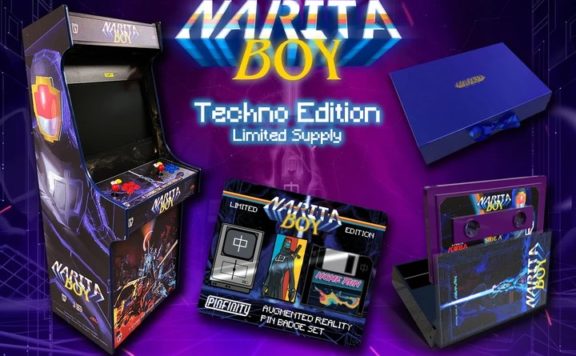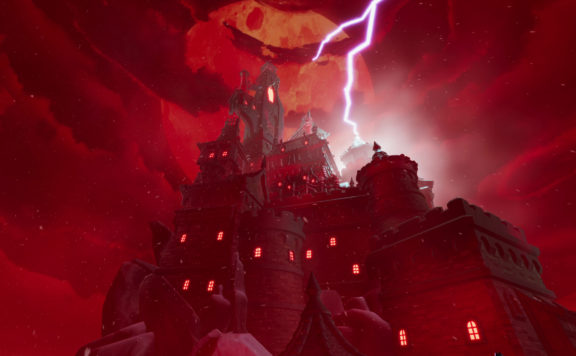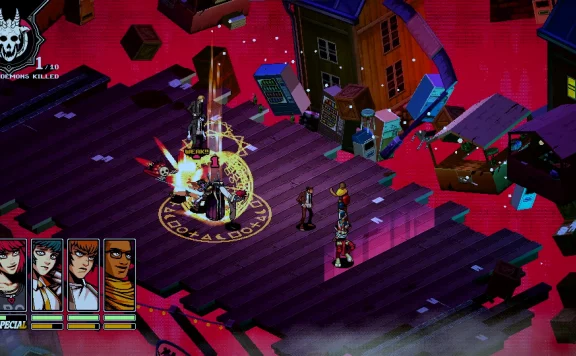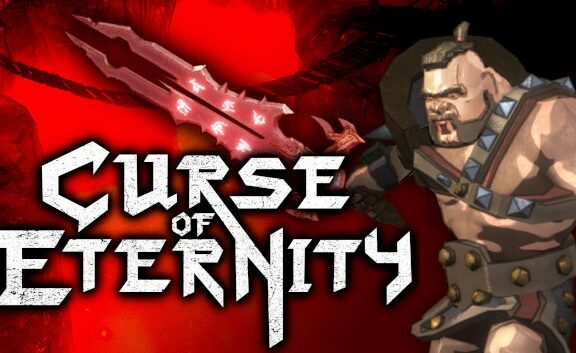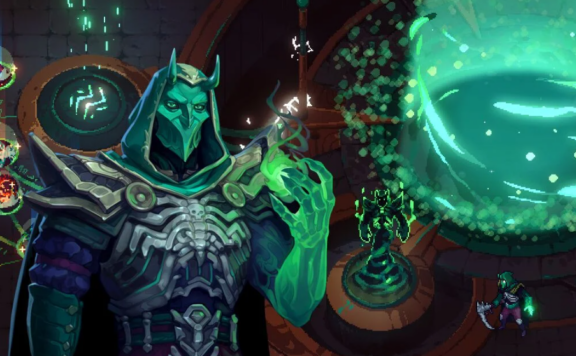When I first saw the trailer for Sword of the Necromancer on Kickstarter, I couldn’t help but be intrigued! Developed by a small team at Grimorio of Games, this 2D dungeon crawler that draws heavy (and unabashed – more on that later) inspiration from the early Legend of Zelda titles while adding options rogue-lite challenges.After all, the animated sequence tugged on the nostalgic strings connected to a title from my past: The Legend of Zelda II: The Adventure of Link! The vibe checked out: swords swinging, skeletons clattering, magical fire blazing, and a seemingly comatose blonde, magical damsel… but this link to my past was broken once the opening sequence ended. In our review of Sword of the Necromancer, we are going to discover if this title can reanimate more than fond feelings of yesteryears.
The story begins with Tama – a bandit-turned-bodyguard for the priestess (or princess) Koko. When Koko falls to fatal attack, Tama seeks out a forbidden power, hidden deep in the crypts of Raena: the power of necromancy, imbued into a weapon to defy the gods. Upon receiving the sword and failing to revive Koko, the Necromancer taunts Tama, drawing her deeper into his lair with the promise of power for the taking. And, this journey will require a lot of it… but, at what cost?

With the Sword of the Necromancer in hand, Tama is able to resurrect the monsters she has defeated to serve as her minions. Much like Tama, they can gain power as they, too, collect experience. But, she shouldn’t get too attached to them because they won’t last long – they will either die in the service of their new master, get replaced with shiny loot, traded for better attributes, or turned into crafting materials. Yes, you read that right…
As Tama progresses through the five levels of the Necromancer’s dungeon – including boss fights, players are given a bit of insight into the relationship between Tama and Koko, involving several misadventures. And this is where Sword of the Necromancer began to lose a fair bit of originality… Let me break down the basics to show you what I mean:
In this story, a brigand/thief gets caught stealing from a princess/priestess who has been sheltered her entire life. In order to gain their freedom, the brigand must accompany the princess/priestess on a pilgrimage to see the world beyond their tower – a world they have never seen. At some point, it is revealed that the princess/priestess has a treasure of great value on their person – which the brigand/thief discovers and could steal, but decides that friendship and love are more valuable than treasure. The princess/priestess has latent magical powers that she has never shown to anyone outside her family and uses this power to heal the brigand/thief. Eventually, the sordid past of the aforementioned brigand/thief catches up with them and it has dire consequences for their companion.
By the end of my experience, I was left feeling like I played Disney’s Tangled if it was set in a meme-ified Hyrule and it was a yuri anime, just to be edgy… and I am not forcing this analogue or being hyperbolic… the above terms are used interchangeably throughout Sword of the Necromancer. What REALLY pushed me over the edge was hearing, with identical inflection, Tama exclaim, “Well, excuuuuse me, princess.”

While every story draws inspiration from some place, Sword of the Necromancer feels like it can’t quite decide what it wants to be, all the way to the end. There is an interesting plot twist following Tama’s encounter with the necromancer, but unfortunately, the narrative is mired in an identify crisis that carries over into how the game itself is played.
While players will find weapons and items along the way, monsters also take up inventory space. With only three main action bar spot and the Sword of the Necromancer as well as four bag slots, players are force to choose if they want to have monsters to level or use their inventory for accessories and equipment. With no designate equipment slots, accessories have to take up an action in order to have any effect on the character. Honestly, this left with a crisis of choice, wondering if I choose the main game mechanic (monster resurrection) or just brute force my way through the dungeons.
This decision was made even more difficult by the erratic nature of combat. While summoned monster can present an advantage, but their behavior and high turn-over rate makes them a gamble to use. On top of that, the sluggish melee controls and oversized hit box of enemy projectiles made me choose an option outside the titular sword and the main gameplay mechanic: I chose the nastiest grimoire I could find, adding damage bonuses to it through crafting, and just blasted everything at range.

To be fair, Sword of the Necromancer does have some redeeming moments. There is something satisfying about bringing your wrecking crew of monsters into a boss fight and beating them down to size – when your monsters decide to fight. Speaking of monsters, their designs are pretty unique and so are the bosses you will face.
The boss fights feel challenging without feeling punishing, thanks in large part to player controlled difficulty Fairly early in the experience, players are give the option to set the game’s overall difficult as well the quality-of-life features they wish to play with. These settings include whether players want to lose their equipment or levels when they die and a perma-death mode as well.
Even though I have some pretty big concerns about its gameplay and narrative delivery, Sword of the Necromancer was a a decent experience overall. I spend around 14 hours in games that I could learn the game’s systems, experiment with play styles, and decide how I best enjoyed playing the game. Once I begin to understand some of the quirks of combat and the behavior of the monsters and bosses, clearing dungeon floors took far less time.

Does Sword of the Necromancer provide a long lost link to the past? It tries hard (a little too hard at moments), but it does offer a fresh idea for how dungeon crawlers are played. The scalable difficulty and the ability to choose which (if any) rogue-lite players is a fantastic feature that I wish more games would include. Subverting the typical format of “heroes versus monsters,” Sword of the Necromancer pushes players to consider just how far they might go in their brokenness before they themselves become the monster… or at least control monsters to serve their needs!
Note: Sword of the Necromancer is available for $14.99 on Nintendo Switch, PlayStation 4, Xbox One, Microsoft Windows, Linux, Xbox Series X and Series S, as well as PlayStation 5. Our copy was reviewed on Microsoft Windows via Steam with a code provided by PR.
COMPARE TO: The Legend of Zelda, Enter the Gungeon, Azure Dreams


